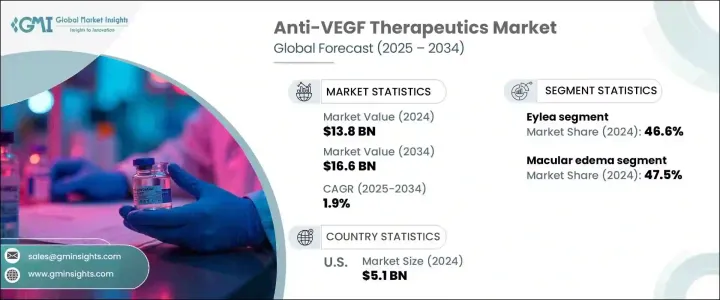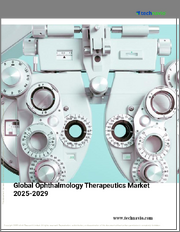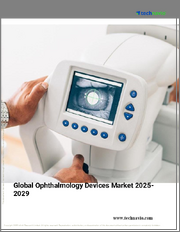
|
시장보고서
상품코드
1684647
항-VEGF 치료제 시장 : 시장 기회, 성장 촉진요인, 산업 동향 분석(2025-2034년)Anti-VEGF Therapeutics Market Opportunity, Growth Drivers, Industry Trend Analysis, and Forecast 2025 - 2034 |
||||||
세계의 항-VEGF 치료제 시장은 2024년에 138억 달러로 평가되었으며, 2025년부터 2034년까지의 CAGR은 1.9%를 나타낼 전망입니다.
이러한 성장은 주로 안과 질환의 유병률 증가, 전 세계 인구 고령화, 사용 가능한 치료 옵션에 대한 인식 제고와 같은 복합적인 요인에 의해 주도되고 있습니다. 이러한 질환은 일반적으로 비정상적인 혈관 성장과 관련이 있으며, VEGF 억제제를 사용하여 효과적으로 치료할 수 있습니다.

이 시장은 인상적인 임상 결과와 더 긴 투약 간격을 제공하는 눈에 띄는 항-VEGF 치료제를 포함한 주요 부문에 의해 형성되고 있습니다. 2024년에는 주사 횟수를 줄여 환자의 편의성과 치료 요법 순응도를 높인 한 치료법이 46.6%의 상당한 시장 점유율을 차지했습니다.
| 시장 범위 | |
|---|---|
| 시작 연도 | 2024년 |
| 예측 연도 | 2025-2034년 |
| 시작 금액 | 138억 달러 |
| 예측 금액 | 166억 달러 |
| CAGR | 1.9% |
용도별로는 황반부종, 당뇨병성 망막증, 망막정맥폐쇄, AMD 및 근시성 맥락막 신생혈관이 시장의 주요 카테고리를 대표합니다. 전 세계적으로 당뇨병 유병률이 증가함에 따라 황반부종의 발생이 악화되어 표적 치료제에 대한 수요가 증가하고 있습니다.
미국의 경우 인구 고령화와 망막 질환의 높은 발병률로 인해 2024년 항-VEGF 치료제 시장은 51억 달러에 달했습니다. 미국의 선진 의료 시스템은 포괄적인 환급 프레임워크를 통해 환자들이 최첨단 치료법에 폭넓게 접근할 수 있도록 보장합니다.
목차
제1장 조사 방법과 조사 범위
제2장 주요 요약
제3장 업계 인사이트
- 생태계 분석
- 업계에 미치는 영향요인
- 성장 촉진요인
- 안과 질환 유병률 증가
- 고령화 인구 증가
- 신약 개발의 기술 발전
- 안과 질환의 적시 치료에 대한 인식 증가
- 업계의 잠재적 위험 및 과제
- 높은 치료 비용
- 부작용과 안전성에 대한 우려
- 성장 촉진요인
- 성장 가능성 분석
- 규제 상황
- 기술적 전망
- 향후 시장 동향
- 갭 분석
- Porter's Five Forces 분석
- PESTEL 분석
제4장 경쟁 구도
- 소개
- 기업 점유율 분석
- 기업 매트릭스 분석
- 주요 시장 기업의 경쟁 분석
- 경쟁 포지셔닝 매트릭스
- 전략 대시보드
제5장 시장 추계 및 예측 : 제품별(2021-2034년)
- 주요 동향
- 아이리아
- 루센티스
- 베오브
- 바비스모
- 기타 제품
제6장 시장 추계 및 예측 : 용도별(2021-2034년)
- 주요 동향
- 황반부종
- 당뇨병성 망막증
- 망막정맥폐색
- 연령 관련 황반변성
- 근시성 맥락막 신생 혈관
제7장 시장 추계 및 예측 : 지역별(2021-2034년)
- 주요 동향
- 북미
- 미국
- 캐나다
- 유럽
- 독일
- 영국
- 프랑스
- 스페인
- 이탈리아
- 아시아태평양
- 중국
- 일본
- 인도
- 호주
- 한국
- 라틴아메리카
- 브라질
- 멕시코
- 아르헨티나
- 중동 및 아프리카
- 남아프리카
- 사우디아라비아
- 아랍에미리트(UAE)
제8장 기업 프로파일
- Alcon
- Amgen
- Bausch Health Companies
- Bayer
- Biogen
- Bristol-Myers Squibb
- Coherus BioSciences
- Eli Lilly and Company
- F. Hoffmann-La Roche
- Hoya Corporation
- Novartis
- Pfizer
- Regeneron Pharmaceuticals
- Sanofi
- Viatris
The Global Anti-VEGF Therapeutics Market, valued at USD 13.8 billion in 2024, is poised to expand steadily with a projected CAGR of 1.9% from 2025 to 2034. This growth is primarily driven by a combination of factors such as the increasing prevalence of eye diseases, the aging global population, and heightened awareness surrounding available treatment options. Age-related macular degeneration (AMD), diabetic retinopathy, and retinal vein occlusion are among the leading conditions fueling the demand for anti-VEGF therapies. These diseases are typically associated with abnormal blood vessel growth, which can be effectively treated using VEGF inhibitors. As these therapies offer significant improvements in vision and overall disease management, they have become an essential part of ophthalmology.

The market is being shaped by key segments, including prominent anti-VEGF therapies that offer impressive clinical outcomes and longer dosing intervals. In 2024, one such therapy captured a substantial 46.6% market share due to its reduced injection frequency, enhancing patient convenience and adherence to treatment regimens. The ability to receive fewer injections has made this therapy the preferred choice among healthcare providers, contributing to its growing adoption.
| Market Scope | |
|---|---|
| Start Year | 2024 |
| Forecast Year | 2025-2034 |
| Start Value | $13.8 Billion |
| Forecast Value | $16.6 Billion |
| CAGR | 1.9% |
In terms of application, macular edema, diabetic retinopathy, retinal vein occlusion, AMD, and myopic choroidal neovascularization represent the main categories within the market. Macular edema, which often results from diabetes and vascular complications, led the market with a 47.5% share in 2024. The rising global prevalence of diabetes has exacerbated the occurrence of macular edema, driving an increased demand for targeted treatments. This shift in prevalence is a significant driver of growth, as more patients are diagnosed and treated for the condition, resulting in a notable uptick in therapeutic needs.
In the U.S., the anti-VEGF therapeutics market reached USD 5.1 billion in 2024, driven by the country's aging population and the high incidence of retinal disorders. AMD remains one of the leading causes of vision impairment, playing a crucial role in market expansion. The advanced healthcare system in the U.S. ensures that patients have broad access to cutting-edge treatments, bolstered by a comprehensive reimbursement framework. This accessibility has allowed more patients to benefit from anti-VEGF therapies, solidifying the U.S. as a dominant force within the global market.
Table of Contents
Chapter 1 Methodology and Scope
- 1.1 Market scope and definitions
- 1.2 Research design
- 1.2.1 Research approach
- 1.2.2 Data collection methods
- 1.3 Base estimates and calculations
- 1.3.1 Base year calculation
- 1.3.2 Key trends for market estimation
- 1.4 Forecast model
- 1.5 Primary research and validation
- 1.5.1 Primary sources
- 1.5.2 Data mining sources
Chapter 2 Executive Summary
- 2.1 Industry 3600 synopsis
Chapter 3 Industry Insights
- 3.1 Industry ecosystem analysis
- 3.2 Industry impact forces
- 3.2.1 Growth drivers
- 3.2.1.1 Increasing prevalence of eye diseases
- 3.2.1.2 Rise in aging population
- 3.2.1.3 Technological advancements in drug development
- 3.2.1.4 Growing awareness towards timely treatment of ophthalmic disorders
- 3.2.2 Industry pitfalls and challenges
- 3.2.2.1 High cost of treatment
- 3.2.2.2 Side effects and safety concerns
- 3.2.1 Growth drivers
- 3.3 Growth potential analysis
- 3.4 Regulatory landscape
- 3.5 Technological landscape
- 3.6 Future market trends
- 3.7 Gap analysis
- 3.8 Porter's analysis
- 3.9 PESTEL analysis
Chapter 4 Competitive Landscape, 2024
- 4.1 Introduction
- 4.2 Company market share analysis
- 4.3 Company matrix analysis
- 4.4 Competitive analysis of major market players
- 4.5 Competitive positioning matrix
- 4.6 Strategy dashboard
Chapter 5 Market Estimates and Forecast, By Product, 2021 – 2034 ($ Mn)
- 5.1 Key trends
- 5.2 Eylea
- 5.3 Lucentis
- 5.4 Beovu
- 5.5 Vabysmo
- 5.6 Other products
Chapter 6 Market Estimates and Forecast, By Application, 2021 – 2034 ($ Mn)
- 6.1 Key trends
- 6.2 Macular edema
- 6.3 Diabetic retinopathy
- 6.4 Retinal vein occlusion
- 6.5 Age-related macular degeneration
- 6.6 Myopic choroidal neovascularization
Chapter 7 Market Estimates and Forecast, By Region, 2021 – 2034 ($ Mn)
- 7.1 Key trends
- 7.2 North America
- 7.2.1 U.S.
- 7.2.2 Canada
- 7.3 Europe
- 7.3.1 Germany
- 7.3.2 UK
- 7.3.3 France
- 7.3.4 Spain
- 7.3.5 Italy
- 7.4 Asia Pacific
- 7.4.1 China
- 7.4.2 Japan
- 7.4.3 India
- 7.4.4 Australia
- 7.4.5 South Korea
- 7.5 Latin America
- 7.5.1 Brazil
- 7.5.2 Mexico
- 7.5.3 Argentina
- 7.6 Middle East and Africa
- 7.6.1 South Africa
- 7.6.2 Saudi Arabia
- 7.6.3 UAE
Chapter 8 Company Profiles
- 8.1 Alcon
- 8.2 Amgen
- 8.3 Bausch Health Companies
- 8.4 Bayer
- 8.5 Biogen
- 8.6 Bristol-Myers Squibb
- 8.7 Coherus BioSciences
- 8.8 Eli Lilly and Company
- 8.9 F. Hoffmann-La Roche
- 8.10 Hoya Corporation
- 8.11 Novartis
- 8.12 Pfizer
- 8.13 Regeneron Pharmaceuticals
- 8.14 Sanofi
- 8.15 Viatris



















